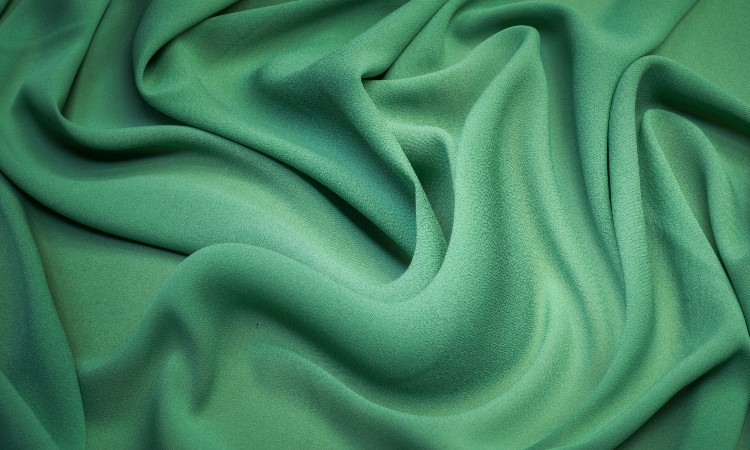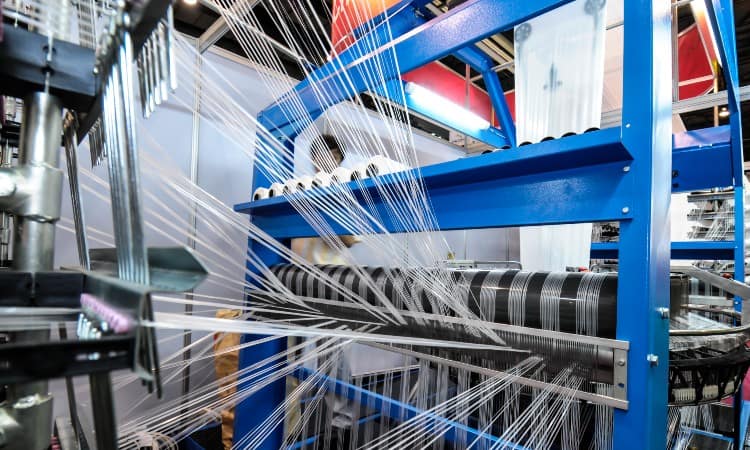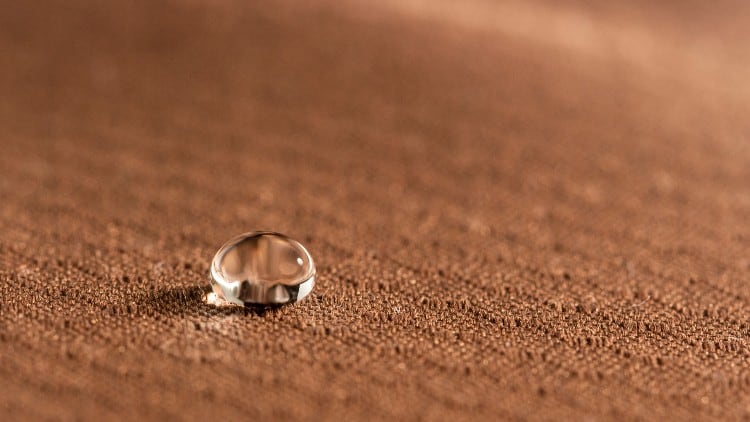Are you looking for a fabric that is versatile, long-lasting, and can withstand the elements? It can be easily cleaned, used both indoors and outdoors, and is inexpensive. Spun polyester may be exactly what you’re looking for. But what is spun polyester and what makes it have those qualities?
Spun polyester is a synthetic fabric that is made by spinning normal polyester fibers into yarn. The yarn is used to make threads in different sizes depending on what the fabric will be used for.
Spun polyester is a different type of polyester that is similar to normal polyester in some ways and different in others. In this article, we’ll take a closer look at some of the spun polyester characteristics and what makes it a great fabric.

What is Spun Polyester Fabric?
Synthetic fabrics are made in a factory and have qualities that make them able to be used for a lot of different things. Since spun polyester is a synthetic fabric, it has certain characteristics that make it a great fabric choice for various projects. Let’s look at these characteristics in more detail.
Characteristics of Spun Polyester
All-Weather Fabric
Spun polyester is sometimes referred to as an “all-weather” fabric. This means that it can withstand being left outside in all kinds of weather without being destroyed. Items made of spun polyester can tolerate those sunny, rainy, or snowy days and still look just as good as they did before.
Durability
All synthetic fabrics are usually long-lasting, but since spun poly is an all-weather fabric, it is extremely durable. It doesn’t tear easily and can withstand a lot of use. Items that are made with quality spun polyester fabric can last years with proper care.
Texture
One of the most important qualities when choosing a fabric is how the fabric feels. You don’t want a fabric to be scratchy, rough, or stiff, which is the case with some synthetic fabrics. On the other hand, spun polyester has a smooth and soft texture that feels similar to that of cotton, a natural fiber.
With polyester and cotton blends, the fabric is softer than normal polyester but shares both fibers’ qualities. With spun poly, you get all the polyester qualities and the softness of cotton without sacrificing the durability that natural fibers sometimes lack.
Wrinkle and Shrink Resistance
Spun poly is also resistant to wrinkling and shrinking. The resistance to wrinkling means that when you launder it, you don’t have to worry about having to take it out of the washer or dryer immediately before it has the chance to wrinkle.
Shrink resistance means that it won’t shrink when it gets wet or dried in the dryer. While you should always be careful to use the correct temperature settings for both the washer and dryer, it is very unlikely that you will accidentally shrink items made of spun polyester.
Colorfast
When fabrics are considered all-weather fabrics, they don’t just tolerate rain and snow but also the sun’s heat. Spun polyester is colorfast, meaning that it holds onto color and won’t fade when left outside on hot, sunny days.
Colorfast fabrics also don’t fade when they are washed, and their colors won’t bleed onto other clothes. You don’t have to worry about items made with spun poly looking dull or dingy; they will continue to look bright and vibrant for a long time.
How is Spun Polyester Fabric Made?

While the basic fiber used to make the spun polyester fabric is the same fiber used when making regular polyester fabric, it is the yarn-making process that sets spun polyester apart. All polyester fibers are created from petroleum, air, and water, using a chemical reaction called polymerization. The way these things are combined is what gives the polyester fiber certain qualities. The process of polymerization leaves behind long “ribbons” of polyester fibers.
But once the fibers are created, they have to be made into yarn. Spun polyester has a texture similar to cotton because once the fibers are created, they are spun to make yarn in a way that is similar to cotton.
To create the spun polyester, the long ribbons of polyester fibers are cut into smaller pieces. The smaller pieces are joined together and then spun using a machine called a spinneret. After spinning, the result is a yarn made up of short fibers. The combination of short fibers creates a soft but smooth texture.
After the spun polyester yarn is created, it is sent to another factory to be woven into the fabric. After the fabric is made, more chemicals and processes are used to give it durability, wrinkle and stain resistance, and colorfastness.
Is Spun Polyester Waterproof?

Spun polyester is not necessarily waterproof, but it is water-resistant. Tiny holes between the woven fibers will allow water to get into the fabric, but the fabric doesn’t hold onto the water for very long. That is what makes spun polyester fabric weather-resistant.
Because of its water resistance, spun polyester won’t grow mildew if it gets wet and is left to air dry. It will also dry quickly, so it doesn’t give mildew much time to grow when it does get wet.
Water-resistance doesn’t only apply to pure water, though. Spun poly is great at repelling liquids that have water in them. This means that fabrics made of spun polyester won’t hold onto stains, and if they do, the stains can be removed easily. That’s another benefit of this type of fabric.
Is Spun Poly Stretchy?
Polyester fabrics by themselves are only somewhat stretchy. All fabrics have a property called elasticity, which gives them some level of stretch and allows them to return to their original shape after being worn. But even with its elasticity, spun poly isn’t the stretchiest of fabrics.
However, spun poly can be blended with other fabrics called stretch fabrics. Stretch fabrics are made with fibers that have high elasticity, like spandex or elastane. Blending these stretch fabrics with spun poly can increase their ability to stretch.
What is Spun Poly Used For?
Spun poly fabrics are more for household use than they are for clothing. Here are some of the most common uses for spun polyester fabric.
Outdoor Use
No products found.Being an all-weather fabric, it is very popular for No products found., pillows, and umbrellas. Think about your patio furniture. It sits outside every day and gets exposed to all kinds of weather conditions, so you would want a fabric that can withstand those conditions.We should mention that spun polyester isn’t the longest-lasting of the all-weather fabrics, but it still lasts a long time. It can also be found in more styles and designs than other fabrics, which is a large part of why it so popular for outdoor use.
Indoor Use
 In addition to outdoor use, spun polyester has indoor uses as well. A lot of bedding is made from spun poly or a stretchy spun thread blend. Bed sheets made from this fabric are both soft and can stretch over the mattress. Generally, they will last a long time.
Fabric tablecloths are another common use for spun polyester. Tablecloths get exposed to many food and spills, so you want them to be made of a material that can be wiped clean or have the stains removed easily. If you are looking for things to make out of spun polyester, consider napkins since napkins are often exposed to the same things that tablecloths are.
In addition to outdoor use, spun polyester has indoor uses as well. A lot of bedding is made from spun poly or a stretchy spun thread blend. Bed sheets made from this fabric are both soft and can stretch over the mattress. Generally, they will last a long time.
Fabric tablecloths are another common use for spun polyester. Tablecloths get exposed to many food and spills, so you want them to be made of a material that can be wiped clean or have the stains removed easily. If you are looking for things to make out of spun polyester, consider napkins since napkins are often exposed to the same things that tablecloths are.
What is the Difference Between Spun Polyester and Polyester?
By now, you know that spun polyester is a variation of the normal polyester that you’re probably more familiar with. Because they are made in different ways, there are some differences between the two.
Filament Polyester vs Spun Polyester
The polyester that you’ve probably been more familiar with up until the point is called filament polyester. With filament polyester, the fibers are still woven into yarns, but the process is different. The filaments are kept long and woven together instead of cut shorter as with spun poly.
The long fibers are incredibly strong, which is what makes polyester so resistant to wear and tear. However, longer fibers also increase stiffness and make polyester texture feel a bit rougher than that of spun polyester. But even with the longer fibers, filament polyester is still a fairly soft fabric.
Similarities Between Spun Poly and Filament Polyester
Both spun poly and filament polyester are extremely durable and long-lasting. They are also water, stain, and wrinkle resistant and have some level of colorfastness. Both fabrics are easy to care for as long as you follow the instructions. When caring for both, you should avoid prolonged exposure to high temperatures in the washer and dryer.
Differences Between Spun Polyester and Filament Polyester
Because filament polyester is made of longer fibers, it is a little more colorfast than 100% spun polyester. This is because the longer fibers hold onto color better than the shorter ones. Filament polyester is also used for clothes more than spun poly because the long fibers make it a slightly stronger fabric. It has to be able to last through many wears and washes.
The spun polyester’s softness makes it a great choice for fabrics that don’t get used as often as clothing. While it is durable, it could start to lose some of its durability the more it is washed. Tablecloths and outdoor cushions aren’t washed that often, which is why spun poly is a great fabric to use for them. Spun poly is also more absorbent than filament polyester because of the shorter fibers. The extra absorbency does take it a little bit longer to dry.
Is Spun Poly Better Than Regular Polyester?
Now that we’ve looked at the similarities and differences between the two, can we say that one of them is better than the other? Not necessarily. Both types of polyester have characteristics that are unique to them, which is why they are used for certain things. The best fabric choice between the two just depends on what you want to make.
Conclusion
We hope this article provided you with the information you needed about spun polyester. Remember that spun poly is still polyester; it’s just made differently. It is a great fabric for outdoor use or indoor cushions, bedding, and kitchen fabrics. If you enjoyed the article, leave a comment and share it with others.